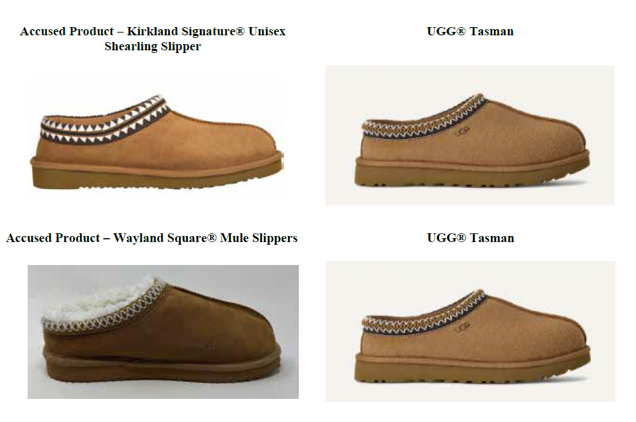On May 8, Deckers Outdoor Corporation (“Deckers”), owner of the intellectual property rights for brands including UGG, Teva, Hoka, and Ahnu, filed two separate lawsuits in the U.S. District Court for the Central District of California. Deckers alleged that Costco’s “Kirkland Signature Unisex Shearling Slippers” and CVS’s “Wayland Square Mule Slippers” are confusingly similar to the allegedly distinctive trade dress of the UGG® Tasman slipper. A comparison of the UGG Tasman slipper and the allegedly infringing Costco and CVS slippers is shown below:

Deckers alleges that the following design features collectively constitute the Tasman trade dress: (1) an embroidered braid around the opening of the upper; (2) a raised seam running down the center; (3) a raised, rounded toe; (4) a brushed, suede-like exterior; and (5) a thick, flat outsole.
Although Deckers does not have a federal trademark registration for the Tasman trade dress, the absence of a registration does not prevent it from asserting trade dress rights. Unregistered trade dress may still be protectable if it is inherently distinctive (in the case of product packaging, discussed below) or has acquired secondary meaning (in the case of product packaging or product design, also discussed below). Deckers alleges that the Tasman trade dress is distinctive and is strongly associated with the UGG brand.
Trade dress generally refers to the “total image and overall appearance” of a product.[1] It can include product design/configuration, packaging, store décor, color schemes, product shape, and even sounds and smells. To qualify for legal protection, and also to attain a registration with the United States Patent and Trademark Office (“USPTO”), a trade dress must satisfy two requirements: it must be (1) nonfunctional and (2) distinctive.
A product feature is considered functional, and therefore not eligible for protection, if it is essential to the product’s utility or affects its cost or quality.[2] For example, a shoe sole designed primarily to improve long-term durability or reduce wear would likely not qualify for trade dress protection because it offers a utilitarian advantage. Functionality is an absolute bar to registration.
In addition, the Supreme Court has distinguished between product packaging and product configuration when evaluating distinctiveness. Product packaging can be distinctive either because it is inherently distinctive or has acquired secondary meaning. In contrast, product configuration (or design) can never be inherently distinctive and can only receive trade dress protection if it has acquired secondary meaning.[3]
Trade dress is said to have acquired secondary meaning when consumers recognize the design as identifying the source of the product, rather than the product itself. On the other hand, product packaging trade dress may also be inherently distinctive if its design or nature readily identifies a single source of the product, even if consumers have never seen it before.
These requirements present strategic considerations for brand owners. On the one hand, registering trade dress with the USPTO offers important legal benefits, including a presumption of ownership, nationwide protection, a presumption of validity, and potentially stronger and more clearly defined enforceable rights. On the other hand, if a trade dress application is refused because the mark is found to be functional or lacking distinctiveness, that refusal becomes part of the public record and may be used as evidence in future disputes. As a result, some brand owners may opt to rely on common law rights based on actual use in commerce to avoid the risk of an adverse decision at the USPTO that becomes public record.
Parties asserting unregistered product configuration trade dress may face challenges in their attempt to enforce their trade dress rights. For example, the presence of third-party products with similar design elements (such as third-party slippers in the Deckers cases) could undermine an argument that a trade dress is distinctive and protectable. If features of an alleged trade dress (such as the upper raised seam or the embroidered braid around the opening of the upper of the Tasman trade dress) are commonly used by other companies in the relevant market, a court may also deem these features to be generic or unprotectable. Courts have found that widespread third-party use of similar product designs can significantly weaken a claim of distinctiveness, especially in product configuration cases.[4]
Parties asserting unregistered product configuration trade dress bear the burden of proving that the specific combination of the elements forming the trade dress has acquired secondary meaning (i.e., in the Deckers case, that consumers recognize the combined elements of the Tasman trade dress as identifying a single source of the slippers). Evidence commonly used to establish secondary meaning in product configuration cases includes “look-for” advertising and substantial product sales.[5]
“Look-for” advertising is a marketing strategy that explicitly directs consumers’ attention to the specific design features claimed as trade dress. In the Deckers case, such “look-for” advertising may include, for example, advertising emphasizing an embroidered braid around the opening of the upper or distinctive seam as a source-identifying element. In addition, demonstrating a high volume of sales of products displaying the alleged trade dress can also help establish secondary meaning where such sales are tied to the public’s recognition of the trade dress at issue rather than to the products more generally.[6] Taken together, these elements are often important in showing that consumers associate the design of a product with a single source (such as associating the Tasman slipper with Deckers and UGG), rather than viewing it as a common design shared by many in the market.
Additional evidence may also be used to help establish secondary meaning. For example, survey evidence from marketing experts, as well as declarations from third parties – such as distributors, resellers, and even infringers who enter into settlement agreements with brand owners to resolve or avoid litigation – can be used to show acquired distinctiveness.
In summary, Deckers’ lawsuits against Costco and CVS highlight important considerations and potential challenges that brand owners may face when enforcing unregistered trade dress rights, particularly in highly competitive markets. While Deckers argues that the Tasman slipper’s trade dress is distinctive and protectable, it may need to overcome potential challenges if CVS or Costco are able to present evidence of extensive third-party use of similar designs, and Deckers will need to meet the burden of establishing that the Tasman trade dress has acquired secondary meaning.
[1] McCarthy on Trademarks and Unfair Competition § 8:1 (5th ed. 2025); see also Trademark Manual of Examining Procedure (“TMEP”) § 1202.02.
[2] TrafFix Devices, Inc. v. Marketing Displays, Inc., 532 U.S. 23, 32 (2001) (citing Qualitex Co. v. Jacobson Products Co., 514 U.S. 159, 165 (1995)).
[3] Walmart Stores, Inc. v. Samara Bros., Inc., 529 U.S. 205, 214–16 (2000); Qualitex, 514 U.S. at 170–174.
[4] Stuart Spector Designs Ltd. v. Fender Musical Instruments Corp., 94 U.S.P.Q.2d 1549, at *5–6 (T.T.A.B. 2009).
[5] McCarthy on Trademarks and Unfair Competition § 8:8.50 (5th ed. 2025).
[6] Inwood Labs., Inc. v. Ives Labs., Inc., 456 U.S. 844, 214 USPQ 1, 4 n.11 (1982) (“To establish secondary meaning, a manufacturer must show that, in the minds of the public, the primary significance of a product feature or term is to identify the source of the product rather than the product itself.”); see also In re Bongrain Int’l Corp., 894 F.2d 1316, 1318, 13 USPQ2d 1727, 1729 (Fed. Cir. 1990) (finding sales success may be insufficient to prove that a mark has acquired distinctiveness where other marks were featured along with it or where sales growth could be attributed to the product’s popularity); In re TBL Licensing LLC, Serial No. 86634819 (T.T.A.B 2021) (not precedential) (Taylor, J.).
